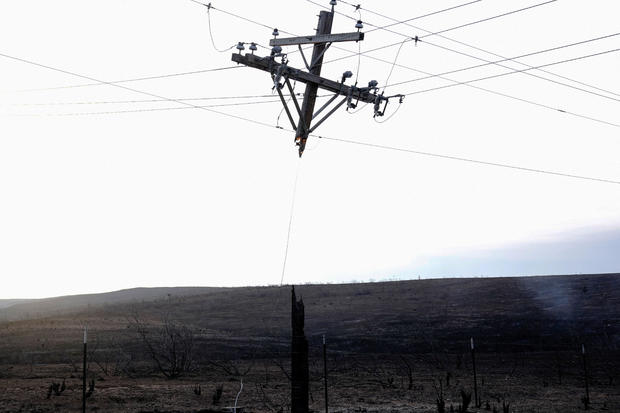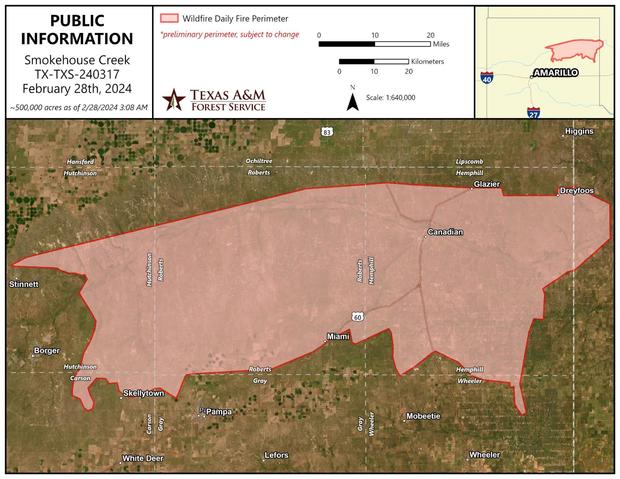In two days, the Smokehouse Creek Fire has grown to be the second-largest in Texas history
In the Texas Panhandle, lampposts are now melted, power line posts are split in half and homes and properties have been reduced to charred remains – and all it took was two days. A wildfire that broke out on Monday has since extended to hundreds of thousands of acres, quickly becoming the second-largest in state history.
Texas A&M Forest Service said on Wednesday that the Smokehouse Creek Fire that started in Hutchinson County has grown to an estimated 500,000 acres. In just two days, it has jumped the line of rankings of the state's biggest wildfires. Previously, the state's second-largest was the Big Country fire which burned up 366,000 acres in 1988. The biggest fire to ever ignite in Texas was 2006's East Amarillo Complex fire, which grew to more than 907,000 acres.
On February 26, the Smokehouse Creek Fire in Hutchinson County ignited in rough terrain and unfavorable weather conditions. Today, the fire is an estimated 500,000 acres, making it the second largest wildfire in Texas history. pic.twitter.com/1txF4dLmD8
— Texas A&M Forest Service (@TXForestService) February 28, 2024
The Forest Service said that the Smokehouse Creek Fire is part of a multi-day wildfire outbreak across Texas and Oklahoma.
Texas Gov. Greg Abbott issued a disaster declaration for 60 Texas counties on Tuesday to secure resources to help fight the massive blazes. High temperatures and dry and windy conditions – all of which is expected to become a more frequent and intense problem as global temperatures rise – contributed to the spread of the flames, Abbott said, with those conditions expected to remain for at least a few days.
"These conditions could increase the potential for these wildfires to grow larger and more dangerous," the governor said. "Texans are urged to limit activities that could create sparks and take precautions to keep their loved ones safe."

In the Texas A&M Forest Service's latest website update on Tuesday, there were five active wildfires – the Juliet Pass Fire in Armstrong County, Grape Vine Creek Fire in Gray County, Smokehouse Creek Fire in Hutchinson County, Windy Deuce Fire in Moore County and Old Bunger Fire in Young County.

The fires temporarily shut down Pantex, the main facility that puts together the country's nuclear arsenal, but the facility, located about 30 miles east of the Panhandle city of Amarillo, is back to "normal day shift operations." No damage or issues were reported.
Wildfires as a whole are anticipated to only get worse as the world continues to burn fossil fuels that release planet-warming greenhouse gases. Last year, scientists at Climate Central released a report finding that wildfire seasons in the U.S. are "lengthening and intensifying, particularly in the West."
Today, several states, including Texas, have two additional months of fire weather compared to what was experienced in 1973, the group found. A combination of low humidity, hot temperatures and wind promote the spread of wildfires.
"Human-caused climate change accounts for at least two-thirds of the rapid increase in fire weather in the western U.S. in recent decades," Climate Central says.
While temperatures are expected to be cooler in north Texas in the middle of this week, the National Weather Service says that warmer conditions will return by Friday, with temperatures 10 to 20 degrees above normal. However, some additional moisture is also expected and the service says that there could be some rain as early as Sunday.
- In:
- Climate Change
- National Weather Service
- Wildfire
- Texas
- Wildfires
- Texas A&M

Li Cohen is a social media producer and trending content writer for CBS News.
Disclaimer: The copyright of this article belongs to the original author. Reposting this article is solely for the purpose of information dissemination and does not constitute any investment advice. If there is any infringement, please contact us immediately. We will make corrections or deletions as necessary. Thank you.





